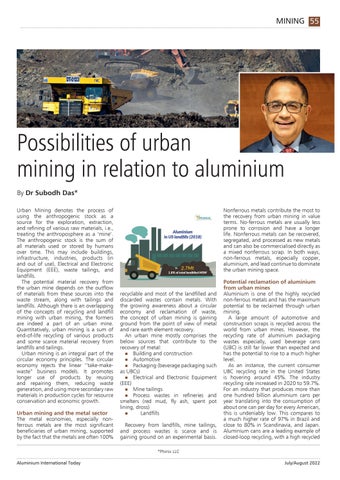MINING 55
Possibilities of urban mining in relation to aluminium By Dr Subodh Das* Urban Mining denotes the process of using the anthropogenic stock as a source for the exploration, extraction, and refining of various raw materials, i.e., treating the anthroposphere as a ‘mine’. The anthropogenic stock is the sum of all materials used or stored by humans over time. This may include buildings, infrastructure, industries, products (in and out of use), Electrical and Electronic Equipment (EEE), waste tailings, and landfills. The potential material recovery from the urban mine depends on the outflow of materials from these sources into the waste stream, along with tailings and landfills. Although there is an overlapping of the concepts of recycling and landfill mining with urban mining, the formers are indeed a part of an urban mine. Quantitatively, urban mining is a sum of end-of-life recycling of various products and some scarce material recovery from landfills and tailings. Urban mining is an integral part of the circular economy principles. The circular economy rejects the linear ‘‘take-makewaste” business models. It promotes longer use of products by reusing and repairing them, reducing waste generation, and using more secondary raw materials in production cycles for resource conservation and economic growth. Urban mining and the metal sector The metal economies, especially nonferrous metals are the most significant beneficiaries of urban mining, supported by the fact that the metals are often 100%
Nonferrous metals contribute the most to the recovery from urban mining in value terms. No-ferrous metals are usually less prone to corrosion and have a longer life. Nonferrous metals can be recovered, segregated, and processed as new metals and can also be commercialised directly as a mixed nonferrous scrap. In both ways, non-ferrous metals, especially copper, aluminium, and lead continue to dominate the urban mining space.
recyclable and most of the landfilled and discarded wastes contain metals. With the growing awareness about a circular economy and reclamation of waste, the concept of urban mining is gaining ground from the point of view of metal and rare earth element recovery. An urban mine mostly comprises the below sources that contribute to the recovery of metal: � Building and construction � Automotive � Packaging (beverage packaging such as UBCs) � Electrical and Electronic Equipment (EEE) � Mine tailings � Process wastes in refineries and smelters (red mud, fly ash, spent pot lining, dross) � Landfills Recovery from landfills, mine tailings, and process wastes is scarce and is gaining ground on an experimental basis.
Potential reclamation of aluminium from urban mines Aluminium is one of the highly recycled non-ferrous metals and has the maximum potential to be reclaimed through urban mining. A large amount of automotive and construction scraps is recycled across the world from urban mines. However, the recycling rate of aluminium packaging wastes especially, used beverage cans (UBC) is still far lower than expected and has the potential to rise to a much higher level. As an instance, the current consumer UBC recycling rate in the United States is hovering around 45%. The industry recycling rate increased in 2020 to 59.7%. For an industry that produces more than one hundred billion aluminium cans per year translating into the consumption of about one can per day for every American, this is undeniably low. This compares to a much higher rate of 97% in Brazil and close to 80% in Scandinavia, and Japan. Aluminium cans are a leading example of closed-loop recycling, with a high recycled
*Phinix LLC Aluminium International Today
Dr Das.indd 1
July/August 2022
06/07/2022 11:59:03
